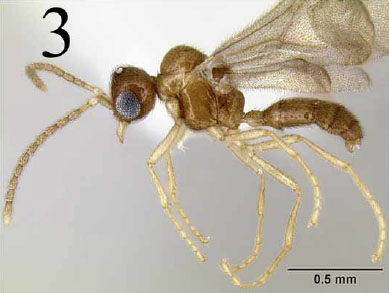
Amyrmex: Dolichoderinae? Leptanilloidinae? Who knew?
A paper out this week in Zootaxa reminds us of the hazards of excessive reliance on the worker caste for ant taxonomy. Phil Ward and Seán Brady sequenced DNA from few genes from the enigmatic Amyrmex, a rarely-collected dolichoderine genus known only from males in South America. Except, it wasn't a dolichoderine. Surprise! Genetically, this little guy is part of the doryline section (the army ants and relatives) in the Leptanilloidinae.
Where did we go wrong with Amyrmex? In my opinion, it's in our dysfunctional dependence on workers. Worker specimens are the most abundant of the castes, of course. They dominate museum collections, and as a consequence ant taxonomy has been constructed almost exclusively on their morphology.
The convenience of a worker-based system carries a cost, however. Workers are highly reduced creatures, natural selection having favored the low-cost solution where body parts present in reproductive insects have been lost, fused, or stripped down to vestigial nubs. The little that remains can converge in form to fit the similar tasks that workers of all lineages perform. Taxonomists don't cope particularly well with characters that no longer exist, and do even worse with convergent similarities.
Generations of myrmecologists placed such weight on the segmentation of the worker petiole that the subfamilies Dolichoderinae and Formicinae were considered to be sister taxa, as both share the derived ancestral state of a single constricted segment (most other ants have two constrictions, or a constriction and a half). But anyone familiar with the males from both groups should have suspected something amiss. Formicine males often bear a certain resemblance to workers- the antennae, for example, are geniculate- while Dolichoderine males are typically pleisiomorphic, looking much more poneromorph than formicine. Without a solid understanding of male characters and male variation, it's all too easy to misplace male specimens.

Dolichoderinae and Formicinae were considered to be sister taxa, as both share the derived state of a single constricted segment
Didn't you mean to write that both share the primitive state of a single segmented petiole?
This was the problem with using the numbers of segments in the waist for grouping. A single segmented waist may be a synapomorphy for Formicidae, but within the family it is symplesiomorphic among the subfamilies sharing it. Having a two segmented waist is derived albeit homoplastic, since in current (and even pre-cladistic) phylogenies it shows as evolved multiple time (i.e., independently in Myrmicinae, Myrmeciinae, Ecitoninae, etc).
I don't know of anybody having consider the single segmented waist derived.
P.S. Damn, how can one write a comment in a forum without sounding angry?
Roberto. Yes- that's a total brain fart on my part. I meant ancestral. I should definitely post *after* coffee. Not before.
I guess it is also a problem for me to live +6 time zones ahead of Chicago. I already had too much coffee today and can't restrain myself...
Where were sites like this back in my childhood? I was completely and utterly obsessed with insects, especially ants, when I was a kid!
Although I now got seduced by protists, it is likely I would have done myrmecology had I not known protists, perhaps from a developmental cell biol perspective. Perhaps learning about the superorganism concept when I was about 8 was part of what got me fascinated about 'strange' ways of being an organism, and ensured I never settle for mundane biology. I've always experienced an irresistible attraction to unusual organisms -- perhaps ants served as a wonderful introduction!
Now I wonder what ants could teach us about the very principles of self-organising systems -- perhaps even aid our understanding of neurobiology?
Your photography is amazing, by the way! Looking forward to further posts.
Cheers,
-Psi-
http://skepticwonder.blogspot.com
PS: Sorry if this double posts... something weird's going on.